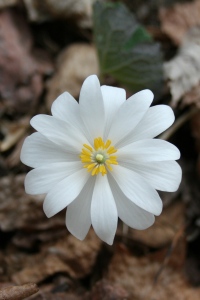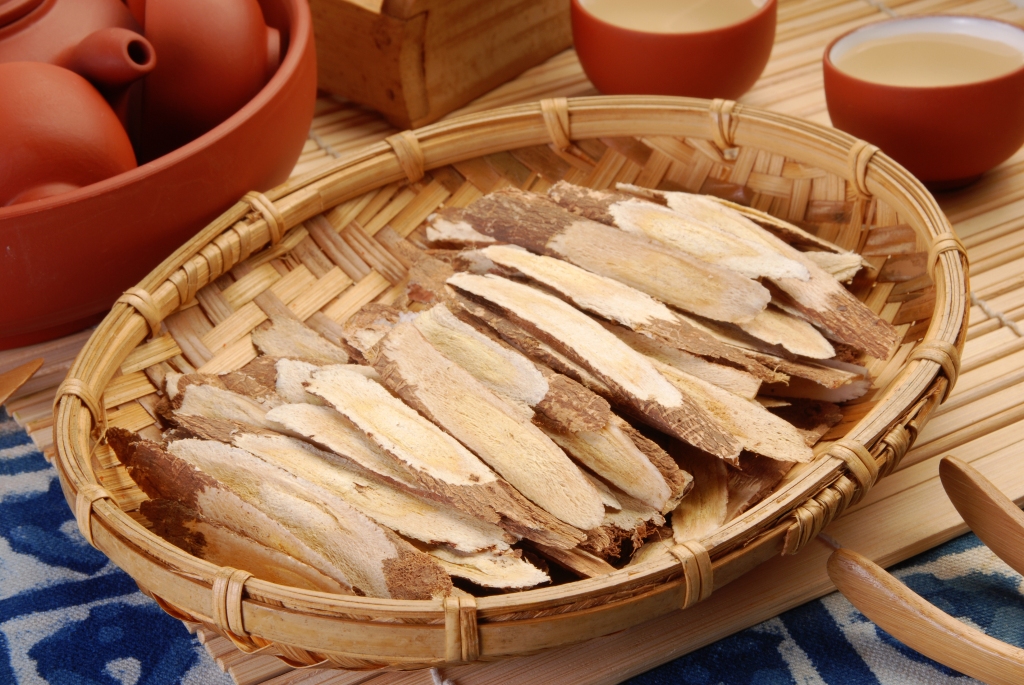
All photos © Thea Summer Deer
When does the appearance of a plant become a sign? When we are willing to stop and listen. Mine appeared as bloodroot precisely on the spring equinox. It was a sign that I had made it through winter. And I did not want the unpredictable and erratic spring season to catch me off guard. After a strangely mild winter and an immune challenging early spring, bloodroot reminded me that it was time to support my liver and gallbladder, the corresponding organ system to spring, and the Wood Element in Chinese Medicine.
I have previously experienced descending into illness at the time of spring equinox. In Chinese Medicine, the equinox is a pause between seasons, the standstill point at the swing-of-the-pendulum when our immune system re-calibrates to the changing light. It is a time to slow down and reflect in accordance with the season.
One spring season, when I got caught off guard, I came down with a bout of bronchitis that took me down hard. It would like to have killed me, threatening pneumonia. That incident required that I recommit to living in harmony with the seasons and a re-bolstering of my immune system. Bloodroot, Sanguinaria canadensis, is a good ally for those who remained attuned. Arriving healthy at the turn of the season, like Persephone resurrected and returned to the light, we can see that our efforts to attune will pay off.

When spring equinox dawns bright and beautiful, I grab my jacket and head for the woods. I can’t think of a better way to celebrate the return than hiking the Blue Ridge through the Pisgah National Forest. Striking out with my son, who has joined me on this day, I make two stream crossings and climb the nearest ridge where views of the mountains were still visible through trees not yet leafed out. The abundant presence of bloodroot, delicate in her ephemeral bloom, was a joyous heralding of spring.
The festival celebrating vernal equinox called Ostara, as the story goes, is characterized by the rejoining of the Mother Goddess and her lover-consort-son, who has spent the winter months in death. With the urging of my son, we walked barefoot down the trail, connecting with the earth and recharging our DNA.
Bloodroot is one of the earliest blooming spring wildflowers and is native to eastern North America and Canada, hence its species name of canadensis. We found it where it likes to grow on wooded slopes above a stream. Deer will eat it in early spring, and anything that deer like to eat usually gets my attention. The flower blooms briefly. And as it fades, the irregularly lobed leaf unfurls and resembles a jigsaw puzzle piece. It is one of the most well-known indigenous medicinal plants in the Appalachians, and it has a long history of use as a respiratory aid.

The flower is beautiful, and its white contrast against the brown, dead, and decaying leaves of an earlier season is captivating. Its flower essence transforms inherited physical, emotional, mental, and spiritual genetic patterns into the light of new potential. Watching my son stepping barefoot into the creek surrounded by these lovely flowers, I said a prayer for the embodiment of our full potential in this lifetime. The energy medicine of bloodroot in the form of a flower essence helps to heal our family lineage and the ancient wounds that live in our DNA. How perfect that my son and I were walking barefoot through the ancestral healing of bloodroot!
Bloodroot is also very useful for treating bronchitis and is effective against chronic congestive conditions of the lungs. In combination with other expectorant and demulcent herbs such as mullein and plantain in a low dosage tincture, bloodroot helps to relieve bronchitis, coughs, lung congestion, and inflammation. It relaxes the bronchial muscles and helps ease difficult breathing. At the same time, it acts as a stimulating expectorant to clear lung congestion, reduces inflammation in the throat and chest, and relieves spasmodic coughs. Sanguinaria’s main herbal actions are expectorant, and antispasmodic. According to David Hoffman, it is one of the best respiratory amphoteric herbs. Amphoteric herbs are normalizers that change and adapt their herbal action depending on the condition.
When harvesting the root of Sanguinaria candadensis care must be taken to wear gloves. The juice from a cut root is caustic and may cause skin irritation. Fresh root poultice is used with caution to treat fungal growths and ringworm. It is also used topically as a salve to treat sores and ulcers. Bloodroot’s alkaloid sanguinarine reduces plaque and gum inflammation when used in dental hygiene products.
Spring is the perfect time to harvest the root when the plant is in full bloom while being mindful not to exhaust the plant population. Once cut, the blood-red root secretes a bright orange juice, hence the name bloodroot. Here in the Appalachians bloodroot is a popular natural red dye used by Native American artists, particularly among the southeastern rivercane basket weavers.

May the ally of bloodroot find its way to you in your time of need. Her flowering essence reminds us of new beginnings in all areas of our lives. As one season, one great cycle ends, another begins, and we are made new. Like Persephone, we will return to the light of knowing that we have everything we need in every given moment and are divinely guided. We are all indigenous to Mother Earth. It’s in our roots. And it’s the blood! Bloodroot, and the flowering of new potential.
Flower Essence: From the bloodroot plant spirit:
This essence helps to heal the ancient wounds that still fester in the DNA of humans today. Assistance with healing family lineage is of critical importance now. Genetic codes are passed down from parents to children that hold both the memory and the forgetting of who we are. It is important to heal that which enlivens the forgetting and the resulting behaviors and illnesses, so the full potential of each person is free to blossom.
— Diana, Tree Frog Farm
Preparation: Tincture made from the fresh root is preferred with the dried root being more suitable for making infused oils and salves. Salves will cause some degree of inflammation and may be an effective external treatment for cancerous growths.
• Fresh root tincture – 1:10 in 50%. Dosage: 10 drops of tincture diluted in water three to four times a day. May also be used as a mouthwash to treat gum inflammation.
• Dried root tincture – 1:5 in 60%. Dosage: 10 – 15 drops diluted in water three times a day.
• Decoction: 1 teaspoon of rhizome in 1 cup of cold water, bring to a boil and infuse for 10 minutes. Drink 3 x a day.
Contraindicated during pregnancy. Low dose botanical – use sparingly and for short periods of time.
References:
Medicinal Plants of the Southern Appalachians by Patricia Kyritsi Howell
Medical Herbalism: The Science and Practice of Herbal Medicine by David Hoffman
Medicinal Plants and Herbs a Peterson Field Guide by Steven Foster and James A. Duke
Wild Roots by Doug Elliott
Wisdom of the Plant Devas: Herbal Medicine for a New Earth by Thea Summer Deer
Disclaimer: The information contained in this post is for educational purposes only. It is not intended to diagnose, treat, or prevent any disease. Some of this information has not been evaluated by the Food and Drug Administration. You should seek medical attention at the first signs of an infection and be under the care of and in communication with a licensed physician, even when you are using herbal alternatives. Be sure to disclose any herbs or supplements you may be taking.
This post contains IndieBound affiliate links which also support Independent Booksellers.

